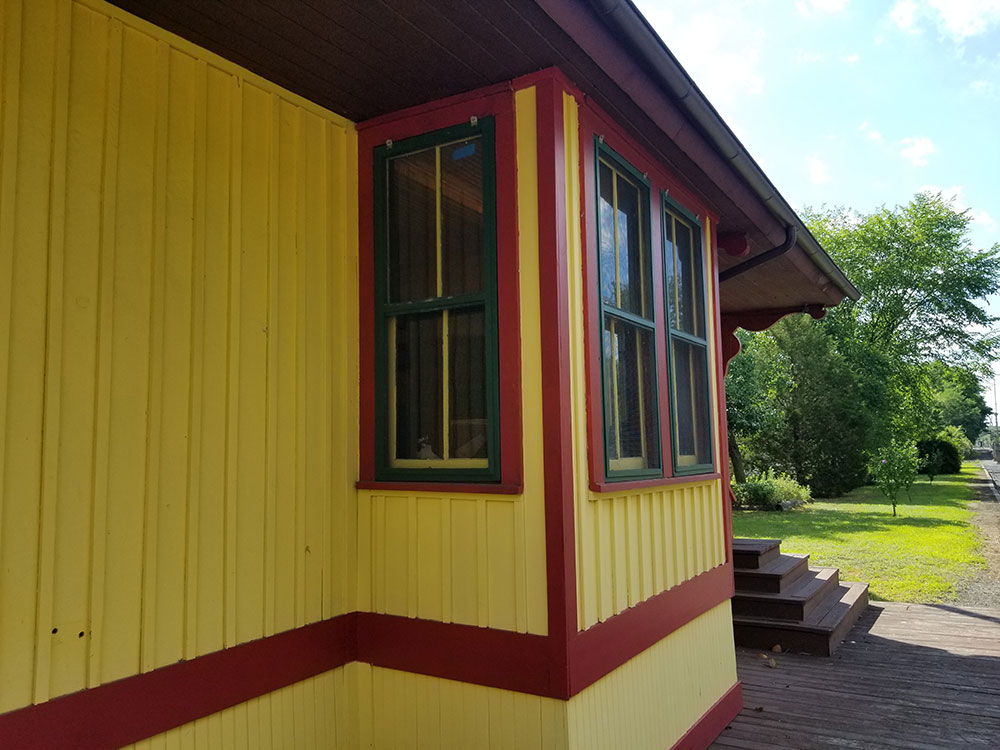The Long-A-Coming Depot is located alongside the railroad tracks between Washington and East Taunton Avenues, in Berlin Borough, Camden County, New Jersey.
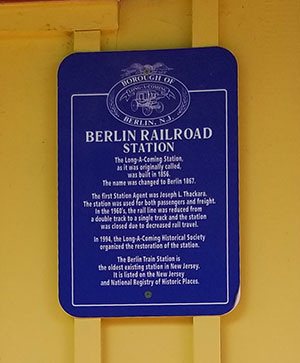 The Long-A-Coming Depot, constructed in 1856, is historically significant for being the oldest railroad station known to survive in the State of New Jersey. This small frame building is located between East Taunton and Washington Avenues, along the railroad tracks in Berlin Borough, Camden County, New Jersey. It was constructed to provide a passenger waiting room, office, and freight room along the Camden and Atlantic Railroad tracks. The Long-A-Coming Depot is on the National Register of Historic Places for its association with the early history of railroad transportation. The structure dates to the first period of development of railroad stations as a building type.
The Long-A-Coming Depot, constructed in 1856, is historically significant for being the oldest railroad station known to survive in the State of New Jersey. This small frame building is located between East Taunton and Washington Avenues, along the railroad tracks in Berlin Borough, Camden County, New Jersey. It was constructed to provide a passenger waiting room, office, and freight room along the Camden and Atlantic Railroad tracks. The Long-A-Coming Depot is on the National Register of Historic Places for its association with the early history of railroad transportation. The structure dates to the first period of development of railroad stations as a building type.
Long-A-Coming, the original name of the area now known as Berlin Borough, began as a small, eighteenth century village fronting the White Horse Pike before the railroad era. The village's name has been attributed to the Indian name, Lonaconing (meaning "where many paths or waters meet") as well as to the village's distance from Philadelphia, which made it "long-a-coming." The early village was known to travelers, as its location halfway between Philadelphia, PA and Absecon Island, NJ, made it a popular rest stop for those taking the stage or their own means of transportation between the two destinations. The popularity of travel to Atlantic City, envisioned as a health resort by Dr. Jonathan Pitney in 1845, had a direct influence on the development of railroads in southern New Jersey. On March 19, 1852, the Camden and Atlantic Railroad company was chartered by the New Jersey Legislature. In October, the sixteen and a half-mile single track laid by that company from Cooper's Point in Camden, through Haddonfield, to Long-A-Coming was formally opened. The line was completed to the Absecon Island, along the Atlantic Ocean, on July 4, 1854, and on that same day, the first trains ran from Camden to Absecon. This event made the Camden and Atlantic Railroad line the first to be constructed that traversed the State and connected to the ocean.
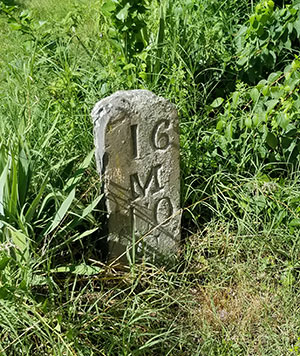 Two years after the completion and opening of the line, the railroad depot was constructed in Long-A-Coming. A railroad timetable from November 10, 1856 reveals that only one train ran each day along this line, taking three and three-quarter hours to travel one way from Cooper's Point to Absecon Island. The first agent for the station was Joseph L. Thackara. Some believe that he was also responsible for building the station. With the adjoining development that was laid out by the Camden & Atlantic Land Company in 1853, the station soon became a very busy location for both travelers and farmers shipping goods on the trains.
Two years after the completion and opening of the line, the railroad depot was constructed in Long-A-Coming. A railroad timetable from November 10, 1856 reveals that only one train ran each day along this line, taking three and three-quarter hours to travel one way from Cooper's Point to Absecon Island. The first agent for the station was Joseph L. Thackara. Some believe that he was also responsible for building the station. With the adjoining development that was laid out by the Camden & Atlantic Land Company in 1853, the station soon became a very busy location for both travelers and farmers shipping goods on the trains.
With the changing names of the village, the name of the station was changed on two occasions. The first name change was from Long-A-Coming to Magnolia, which occurred on February 5, 1867. On May 7 of the same year, the name was changed to Berlin, which it retains today.
In the last two decades of the nineteenth century, the railroad had become increasingly busy, and it played a dominant role in the economy of the village. In order to accommodate more traffic, a double-track line was completed to Berlin in 1892. A year later, the line was taken over by the Reading Company. The double-track line was completed to the shore by 1898. With the increased amount of trains, more and more people came to Berlin and built houses in the area.
In the 1920's, the popularity of the railroad began to wain as it received competition from the automobile, the newly developed means of transportation. To improve business, on June 25, 1933, the Pennsylvania and Reading companies merged as the Pennsylvania-Reading Seashore Lines. This line enjoyed a period of popularity as it accommodated visitors traveling to the popular seashore resorts.
The second half of the twentieth century marked the end of the railroad era, and the line was reduced to a single track. Numerous stations throughout the country were closed or demolished. The Long-A-Coming Depot had stood vacant since the 1960's. Then on July 20, 1992, the Borough of Berlin leased the building with the intent to preserve it as a meeting place and museum of local history. Members of the Long-A-Coming Historical Society, under the project leadership of Roy Schmidt and Daniel Pomponio, began their restoration and rehabilitation efforts in the Spring of 1994.
Architecturally, the railroad station has retained the majority of its original features including its distinguishing wooden brackets, two sliding wood freight doors, four-paneled waiting room door, two-over-two windows, structural framing, floor plan, and massing. The interior contains some modern finishes, such as wood flooring and beaded-board paneling; however, these elements closely resemble the earlier finishes, which survive underneath.
Genius Value
Long-A-Coming is the oldest surviving train station in New Jersey. Apparently it contains a museum run by the local historic society, but it was not open when we visited. There were no signs indicating when it would be open. The only interpretive information is a small sign on the south side of the building.
Arrival
We arrived travelling south on Route 73. The right turn for Washington Ave is just after East Tauton Ave (which has a traffic light). Washington Ave is a small street with a speed limit sign on its corner. After turning onto Washington Ave, the depot is just just down the road - impossible to miss.
Parking
There is an ample parking lot right around the depot. Parking is free.
Ticketing
There is no charge to look at the depot, however the historic society that runs it has membership options.
The Depot
This one-story frame railroad station was constructed in 1856 in the Italianate Vernacular style. The station is approximately fifty feet long adjacent to the tracks and approximately twenty-five feet wide. On the north elevation, facing the tracks, an eight and a half-foot wide bay window projects five feet out towards the tracks.
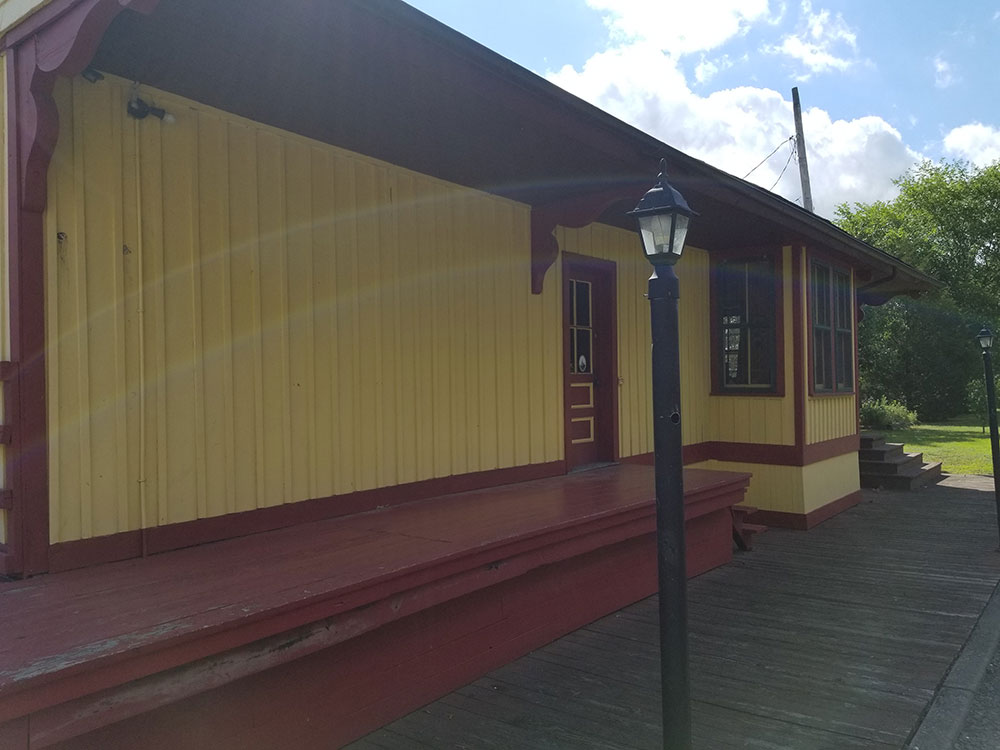
Extending the footprint of the building is an eight-foot wide platform on the east elevation, a seven-foot wide platform on the east three-quarters of the south elevation, and a narrow platform on the east half of the north elevation. The station is surrounded by asphalt paving on the east side, a stone gravel drive on the south side, low-growth wild vegetation on the west side, and a combination of paving and sandy soil on the north side up to a concrete retaining wall that is adjacent to the tracks.

The exterior of the building is distinguished by vertical battened board walls with wood shingles on the gable ends and large wood brackets under the projecting eaves. The west half of the building was constructed on a crawlspace while the east half is on piers. Both the crawlspace and the piers are brick masonry with areas of concrete infill and patching. All of the original two-over-two wood windows survive. There are two small modern windows on the south elevation that have been added for an internal restroom.
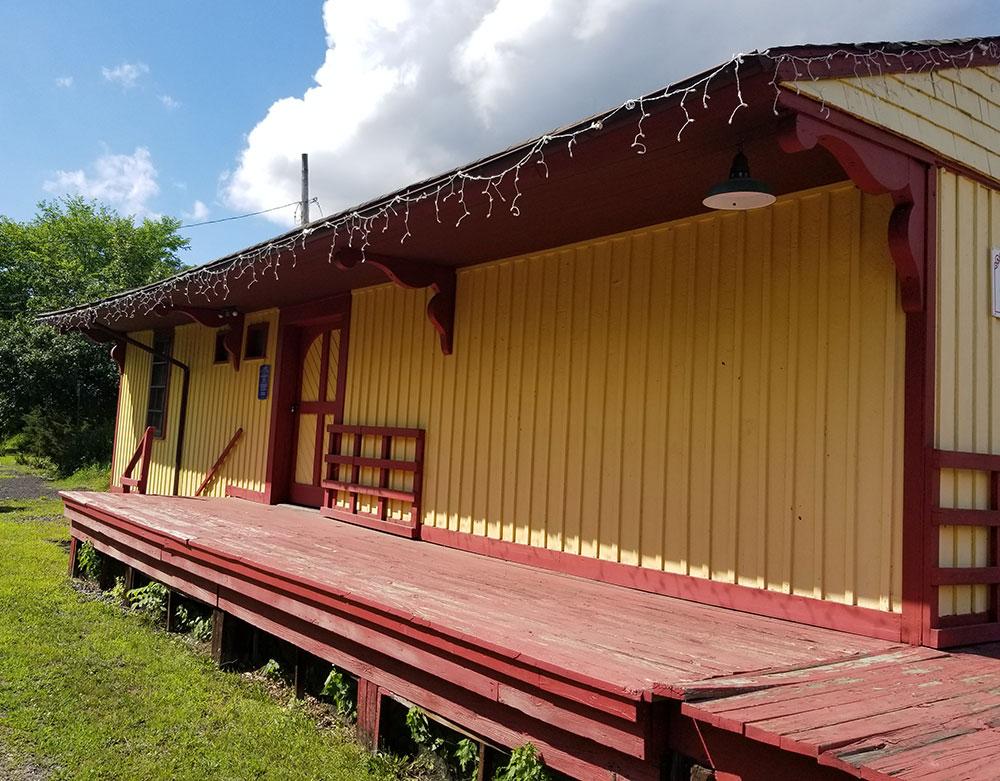
The original four-panel door on the north elevation leading into the waiting room on the west end of the building remains intact. Two of the three original sliding doors for the freight room on the east half of the building have also survived. In the second half of the twentieth century, the freight door on the north elevation was removed and replaced with the standard-sized beaded-board door that remains today. The gable roof was previously covered with a standing seam metal roof; however, it is now covered with modern asphalt shingles. Open wood stairs are located on the north elevation at the waiting room doorway and platform, and on the south elevation at the west end of the platform.
The interior of the station retains its original three-room floor plan with the exception of a fourth room which was added along the south wall to serve as a restroom. The largest room is the freight room on the eastern half of the building. This room is twenty-seven feet long and twenty-five feet wide, spanning the entire width of the building. The freight room has original thick board flooring and an open ceiling exposing the vertically sawn, bolted wood truss structure. Some of the early beaded board paneling survives on the west wall, and similar beaded-board paneling has been installed on the other walls. The eight and a half-foot wide by three-foot deep handicapped- accessible restroom in the middle of the building on the south end contains a modern sink and toilet. The west half of the building is divided into a middle room that corresponds with the exterior bay window and another large room to the west. The middle room, which was used as the office, is eight and a half feet wide and extends twenty-two feet to the south. This office had a desk in the projecting bay which served as an ideal vantage point for viewing and controlling the train traffic. The original ticket window on the west wall and safe on the east wall have been well-preserved. The east and west walls of this middle room are also each pierced with two doorways. The west room served as the waiting room. This room is fourteen and a half feet wide and, similar to the freight room, it occupies the entire depth of the building.
Both of the original rooms in the west half of the building were finished with similar details including original woodwork (held with machine-headed, horizontal-fiber cut nails), new wood flooring over the original wood flooring, and new beaded board paneling on the walls and ceiling over the matching earlier paneling which covers the original plaster.
Conclusion
The Long-A-Coming Depot holds a unique place in history as being New Jersey's oldest surviving train station. It's well maintained and apparently has a museum inside. It's not clear when the museum is open, though. It's a quick side trip from a main highway if you are in the area, but not really worth a special trip unless you are very interested in railroad history.
Other Resources
Long-A-Coming Historical Society
